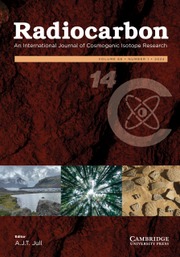No CrossRef data available.
Article contents
Quantification of excess carbon-14 specific activity in soil and sediments in the vicinity of a nuclear power plant by batch combustion and liquid scintillation counting method
Published online by Cambridge University Press: 08 May 2025
Abstract
The application of a tube combustion system (pyrolyzer) for the batch combustion of low carbon content environmental matrices, such as soil and sediment, for determining 14C specific activity is examined. The samples were combusted at 600°C, and the CO2 species produced were trapped in 3N NaOH, precipitated as BaCO3 by adding BaCl2, and subjected to acid-hydrolysis to transfer the CO2 species to the absorber-scintillator mixture for liquid scintillation counting (LSC). The method was validated by analyzing the samples by accelerator mass spectrometry (AMS) method. The minimum detectable activity (MDA) for the method, at 2σ confidence level, was 10 Bq kg–1C (4 pMC) for a counting time of 500 min and 7 Bq kg–1C (3 pMC) for 1000 min. The capability of the method to quantify a small excess of 14C specific activity (a few Bq kg–1C or pMC) in the environment of a nuclear facility, when compared to the ambient natural background level, was demonstrated by analyzing a total of 23 soil and 7 sediment samples from the vicinity of a pressurized heavy water reactor (PHWR) nuclear power plant (NPP) at Kaiga, India. The maximum excess 14C specific activity values recorded for soil and sediment matrices were 37 ± 7 Bq kg–1C and 11 ± 7 Bq kg–1C, respectively, confirming minimal radioecological impact of the operation of the NPP on the environment. The 14C specific activity ratio for the recently fallen leaf litter and the soil underneath at most of the sampling points in the vicinity of the NPP had a mean value of 1.03 with an associated standard deviation of 0.07. Statistical tests confirm that the mean values of the data set of 14C specific activity of leaf litter and underlying soil are not significantly different.
Keywords
Information
- Type
- Research Article
- Information
- Copyright
- © The Author(s), 2025. Published by Cambridge University Press on behalf of University of Arizona


